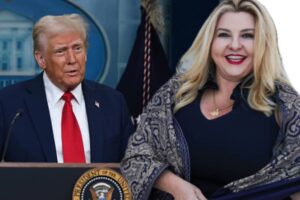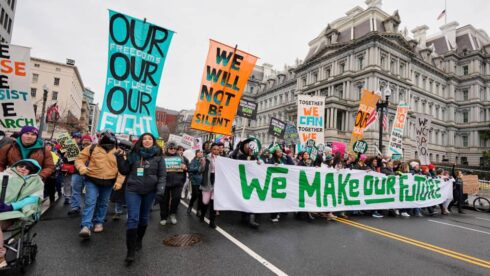Thousands of demonstrators flooded the streets of Washington, D.C., on Saturday, voicing their opposition to President-elect Donald Trump’s second-term inauguration. The protest, dubbed the “People’s March,” brought together activists advocating for women’s rights, racial justice, reproductive freedoms, and climate action, among other causes. Protesters braved light rain as they marched past the White House and gathered near the Lincoln Memorial, mirroring the large-scale demonstrations that followed Trump’s first inauguration in 2017.
Unlike the 2017 Women’s March, which saw millions rally against Donald Trump’s presidency, this year’s protests were significantly smaller. Organizers initially expected around 50,000 attendees, but local law enforcement projected a turnout closer to 25,000. Nationwide, over 300 coordinated marches were planned, reflecting the widespread discontent among progressive groups. Many demonstrators wore the iconic pink hats that symbolized resistance during Trump’s first term, signaling their continued opposition to his policies.
Diverse Activist Groups Rally Against Donald Trump’s Agenda
The demonstration was spearheaded by a coalition of organizations, including reproductive rights groups, civil rights activists, environmental advocates, and immigration reform supporters. Many attendees expressed concerns over Trump’s plans to roll back federal protections, dismantle government agencies, and implement stricter immigration policies. His previous term saw numerous executive orders that curbed abortion access, weakened climate regulations, and imposed travel bans targeting Muslim-majority nations, leaving activists wary of what his second term could bring.
Olivia Hoffman, a 26-year-old advocate from the Young Women’s Freedom Center in California, traveled with her mother to join the march. “A lot of people are disillusioned,” she said. “We feel like we’ve been fighting for the same things for so long.” Protesters held signs calling for the protection of democracy, human rights, and social justice, emphasizing the broader implications of Donald Trump’s leadership beyond U.S. borders.
Donald Trump’s Electoral Victory Sparks Backlash
Donald Trump’s return to the White House comes after his victory over Democratic Vice President Kamala Harris in the November election. His path to re-election was marked by decisive wins in all seven battleground states, securing both the Electoral College and, for the first time in two decades, the popular vote for a Republican candidate. The outcome disappointed many within the women’s rights movement, as Harris would have been the first female U.S. president. Some activists noted a sense of fragmentation within the movement, which may have contributed to the smaller protest turnout compared to 2017.
Despite the discontent, Donald Trump’s supporters have lauded his campaign promises, including aggressive immigration enforcement and cuts to federal bureaucracy. His administration has signaled plans to launch nationwide immigration raids and reshape federal agencies, policies that have fueled tensions with advocacy groups and international allies. One protester carried a sign reading, “We are not your 51st state,” condemning Trump’s stance on U.S.-Canada relations and perceived pressure on the neighboring country.
The People’s March: A Legacy of Resistance
The first Women’s March took place in 2017, the day after Trump’s initial inauguration, drawing hundreds of thousands of participants in Washington, D.C., and inspiring millions more to demonstrate nationwide. Protesters famously wore pink “pussy hats,” referencing Trump’s controversial remarks about women that surfaced during the 2016 campaign.
In the years following, the march became a central symbol of the anti-Trump resistance, though participation gradually declined. Organizers of this year’s march acknowledged the lower turnout but emphasized that their commitment to opposing Trump remained steadfast. According to their website, the movement seeks to “draw on past successes and effective strategies against autocrats” to challenge Trump’s leadership.
A Growing Resistance Movement for the Next Four Years
While the protests were smaller than in 2017, they underscored persistent opposition to Donald Trump’s presidency and policies. Activists stressed that their fight would not end with the inauguration, vowing to mobilize against legislation and executive orders that threaten civil liberties. The presence of diverse advocacy groups suggested a broad coalition of resistance that could shape political discourse in the years ahead.
With Trump set to take office on Monday, demonstrators pledged continued vigilance and activism. Many emphasized the importance of grassroots organizing, voter engagement, and legal challenges to counter the administration’s agenda. “This is just the beginning,” said one organizer. “We’re here to remind the world that we won’t be silent.”.
Donald Trump Arrives in Washington as Tensions Simmer
As protesters marched through Washington, Trump arrived in the capital later that day to kick off his inaugural festivities. He attended a private event at his Virginia golf club, which featured a fireworks display. Meanwhile, a small group of Trump supporters gathered near the Washington Monument, donning the iconic red “Make America Great Again” hats.
One of the Trump supporters, Timothy Wallis from Idaho, observed the protest and noted that while he respected the demonstrators’ right to voice their opinions, he was puzzled by the hostility. “It’s sad where we’re at as a country,” he said, reflecting on the political divisions in the United States.
Despite the lower turnout, many protesters remained committed to resisting Donald Trump’s agenda. Susie, who traveled from San Francisco to join her sister Anne in the march, remarked on the movement’s enduring spirit. “This time the stakes are higher,” she said, expressing concerns about Trump’s influence over wealthy elites and major tech companies. Anne acknowledged that many protesters might be “out of touch” with mainstream America, given Trump’s sweeping victory in key swing states. However, she remained defiant: “We’re still here, and we will resist.”














